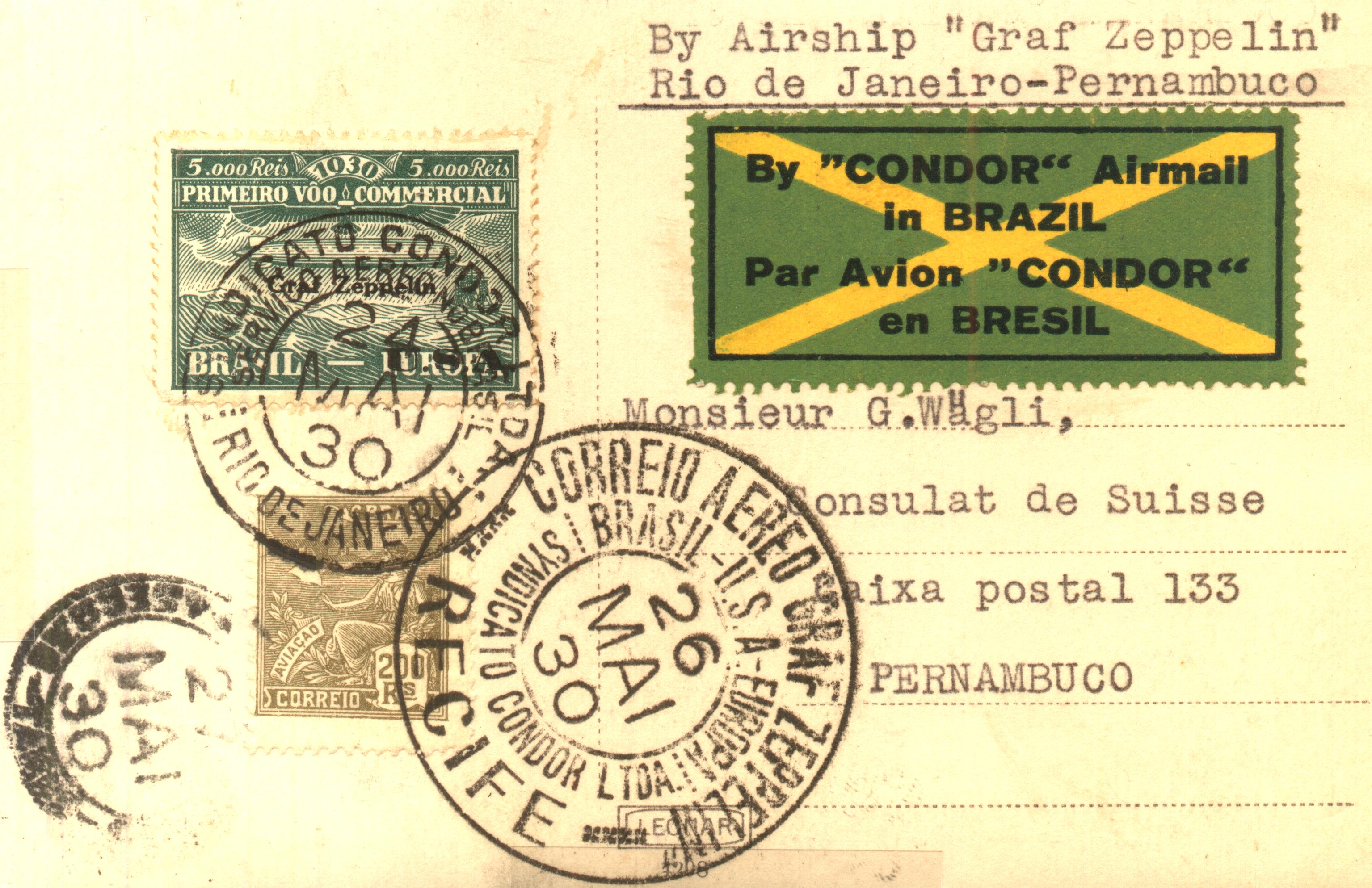 Figure 1: Typical Wägli
cover (Sieger No.59D) using the Swiss Consulate in Pernambuco.
Figure 1: Typical Wägli
cover (Sieger No.59D) using the Swiss Consulate in Pernambuco.|
© Dr. Artur Knoth |
Brazilian Philately: The Pan Am Zeppelin Flight of 1930 |
Pseudo and Real Official/Diplomatic Mail out of Brazil on the 1930 Pan Am Zeppelin Flight
I. Introduction
There are covers on the 1930 Pan Am Zeppelin Flight that involve consulates and embassies in one form or the other. In this article, I want to take a look at some of these and demonstrate some of the many auxiliary markings (not strictly postal) that one can encounter on these covers. I've decided to break up this subject of “diplomatic” covers into three classes, defined as follows:
|
1 |
These are covers addressed to the national consulate/embassy situated in the country of one of the flight destinations, with the officials hopefully relaying the covers back to their addressers. Basically these are philatelic covers. |
|
2 |
These are covers were sent by a member of the actual embassy and/or consulate staff. Though mainly philatelic in nature, they may have even been actual, time critical, letters that made used of the speed the Zeppelin offered. Without the contents of these latter covers, this possibility cannot be confirmed. |
|
3 |
These, if they exist, would encompass actual, real diplomatically franked mail sent on the Zeppelin. |
II. Class One Covers
Collectors of many countries used their consulates as destinations, instead of or in addition to the postal „poste restante“. For this article, we'll look at two specific countries as examples.
The Swiss Connection
Any one collecting Zeppelins covers literally stumbles across „tons“ of „Wägli“ covers such as shown in Fig. 1. Herr Wägli seems to have been a Swiss postal official (stationed in Basel?) that seems to have gone through the complete list of consulates and embassies in the whole world, where ever the Zeppelin had a stop.
 Figure 1: Typical Wägli
cover (Sieger No.59D) using the Swiss Consulate in Pernambuco.
Figure 1: Typical Wägli
cover (Sieger No.59D) using the Swiss Consulate in Pernambuco.
The USA Connection
Restricting the discussion to just Brazilian franked covers, a lot of US collectors addressed covers to their representatives in Brazil, Spain, France and many more. Most of these covers were sent through the good offices of the Zeppelin representative von Meister and carry the typical “von Meister” numbers /1/.
On the Pernambuco to Rio de Janeiro leg of the flight, I have examples by the collectors
- H.D.Egolf
- H.A.Truby
- Frank Donohue Jr.
sending covers on this leg, each receiving the same arrival marking of the American Consulate in Rio (Fig. 2). An interesting detail is that the quality of the strikes of the receiving device can vary, but on the basis of several covers, the damaged „6“ in the date seems to be a constant feature.
The letters sent on the Brazil-Spain leg were usually addressed to consulates in Seville and Barcelona. Yet on these covers I have not yet seem an arrival strike of the respective American representations in these cities. But a Truby addressed cover to the US Embassy in Madrid received an arrival mark on the back as shown in Fig. 3.
Finally, I have a cover sent to France. In this case, Marx Reimers addressed a letter not only to the US Embassy in Paris, but directly to the Chief Mail Clerk, Warren M. Hamilton. This yielded the marking of Fig. 4, the official Parisian version in French.
III. Class Two Covers
In this class, as mentioned, the cover originated with a consular or an embassy addresser. As the weakest examples in this category are the following two covers:
- a cover to Havana, only when you look at the back do you see that someone in the Swiss consulate in Pernambuco was the addresser – but not Wägli (Fig. 5 and 6)
- cover sent to Germany, and as above, the back indicates that the envelope is official consular stationary (Fig. 7 and 8). This last example is especially interesting due to the franking. Two of the „emergency“ overprinted 5$000/1$300 stamps were used to complete the later letter rate of 10$000.
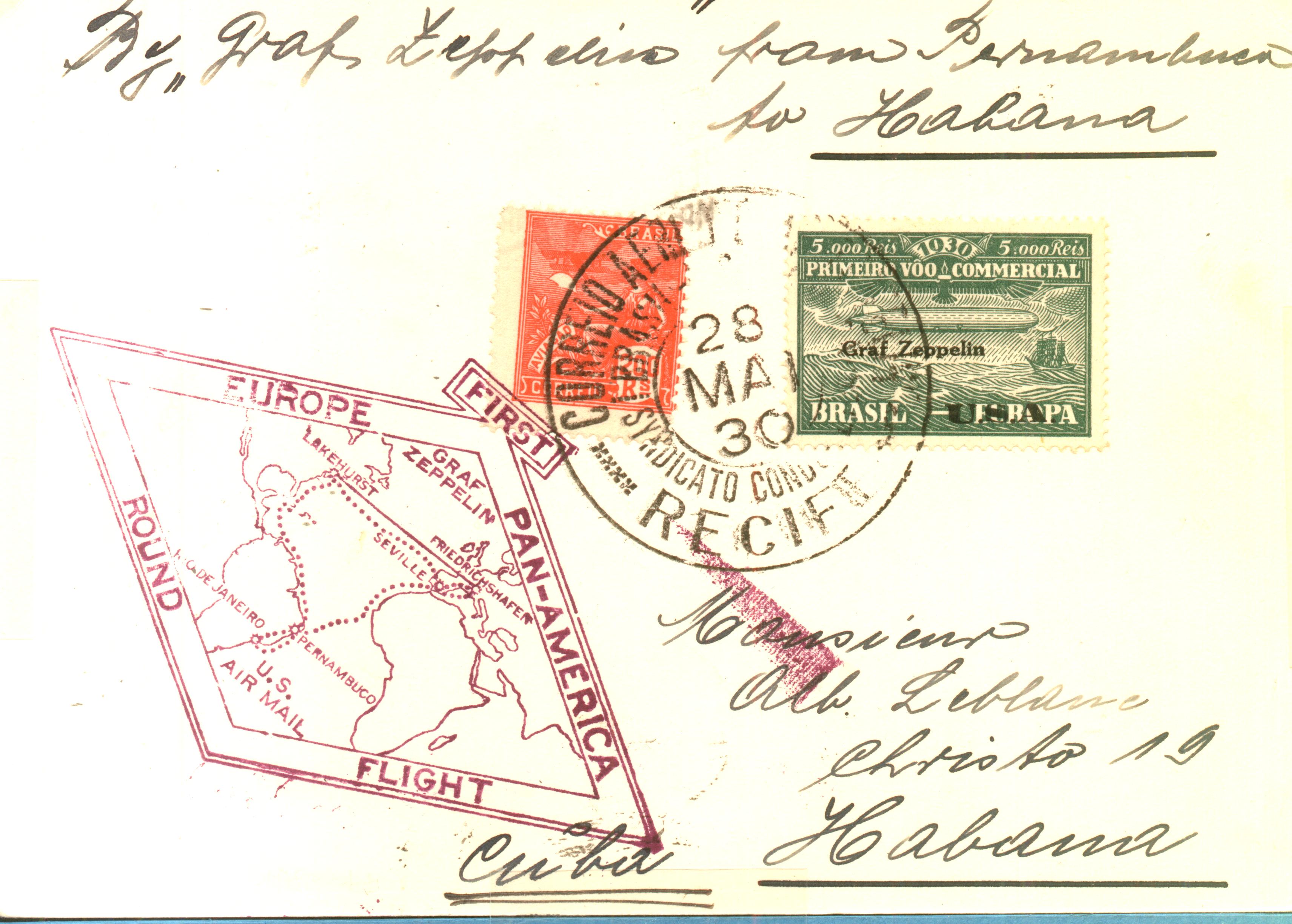 Figure 5: A „typical“
cover sent to Havana.
Figure 5: A „typical“
cover sent to Havana.
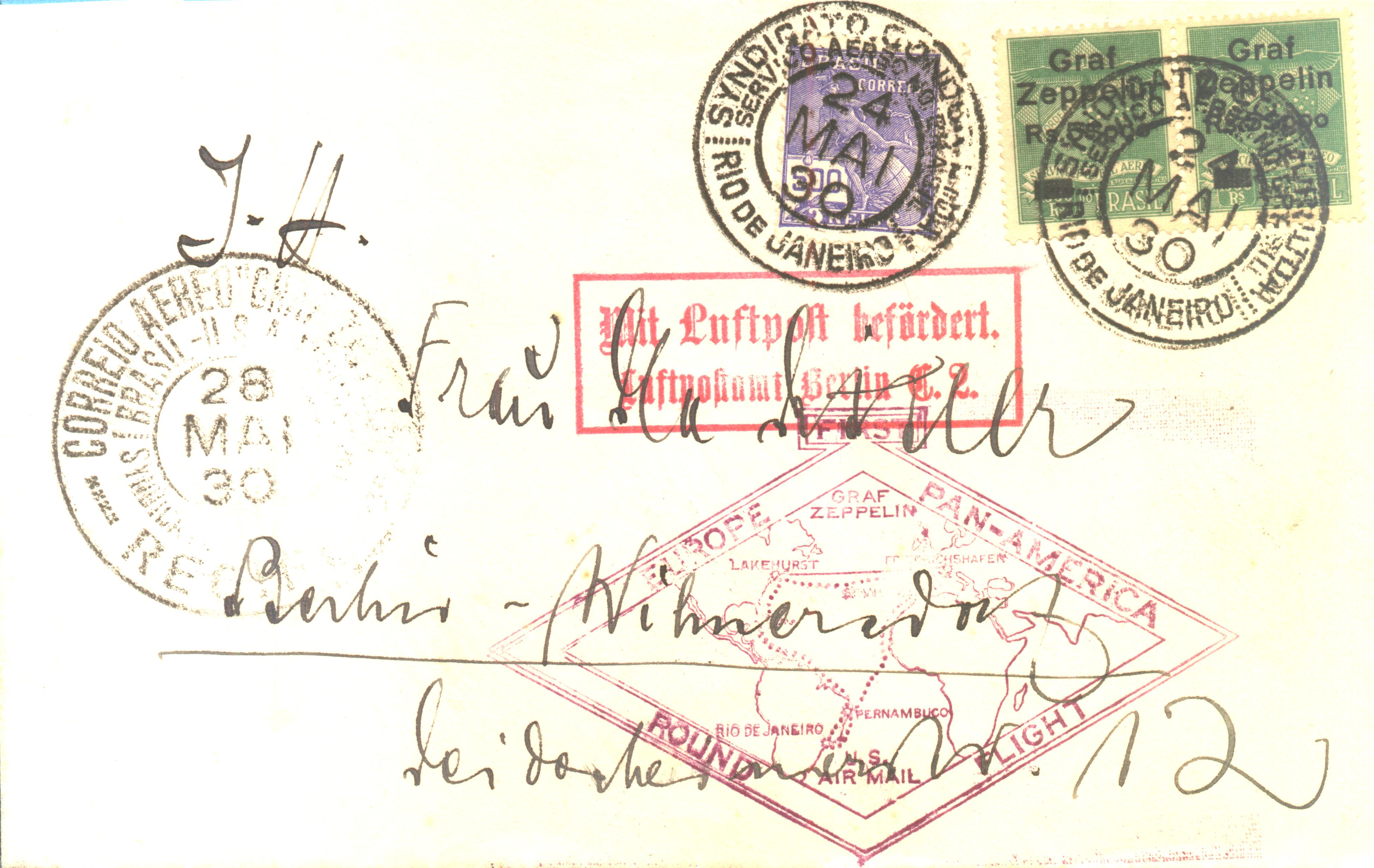 Figure 7: Rare use of the
special 5$000/1$300 stamps as a pair on a cover to Germany using
German consulate stationary.
Figure 7: Rare use of the
special 5$000/1$300 stamps as a pair on a cover to Germany using
German consulate stationary.
The next covers are more interesting and might be a little more „official“, i. e. not patently philatelic in nature, although this can't be proved one way or the other.
The first of these covers is a letter sent from Rio de Janeiro by the Portuguese Consul in Santos to his counterpart in New York City (Fig.9 and 10). Difficult to obtain in a scan is the embossed coat of arms of the Portuguese Republic, i. e. official stationary. This could, on the one hand, have been an official communication between the two consulate, or just a favor to get a cover of this flight. Note a “European” version was used on a letter to the US!
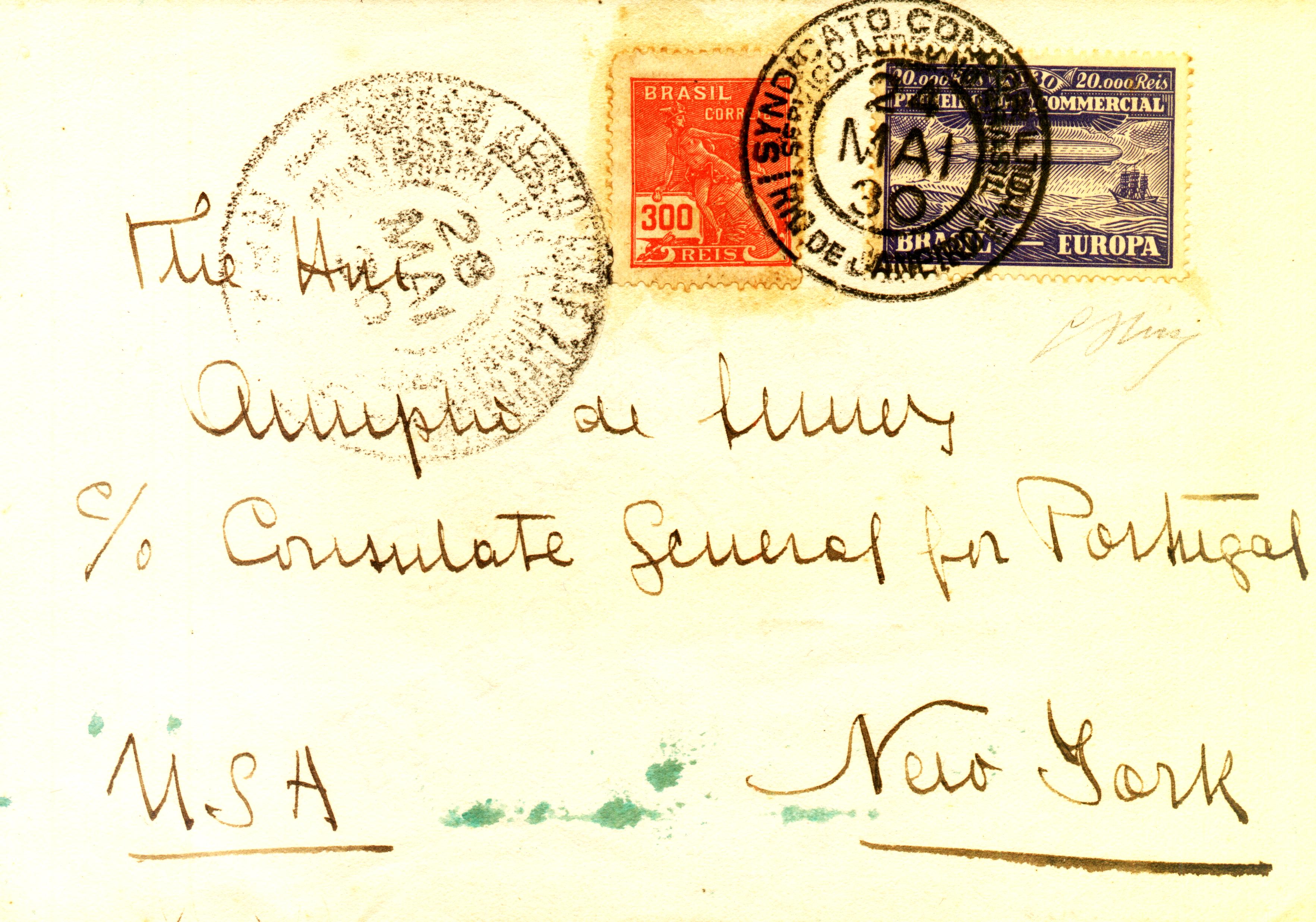 Figure 9: Front of cover
addressed to Consulate of Portugal in NY City.
Figure 9: Front of cover
addressed to Consulate of Portugal in NY City.
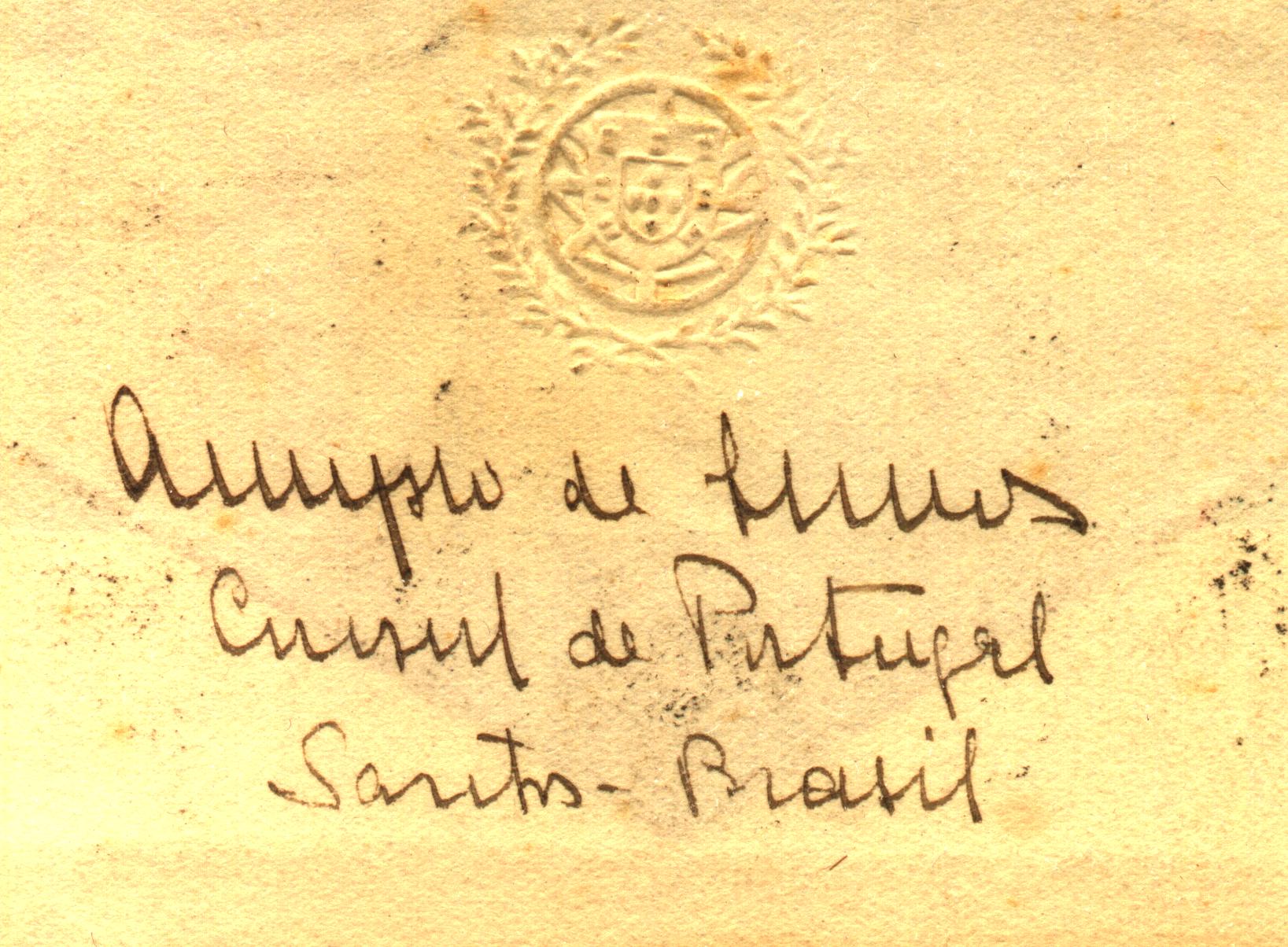 Figure 10: Back of cover
with return address of Port. Consul in Santos, Brazil.
Figure 10: Back of cover
with return address of Port. Consul in Santos, Brazil.
The next letter of this group (Fig. 11) is a cover sent by the Austrian Consul in Sao Paulo to a representative of the Swiss cement industry. Again official stationary was used. If the letter was truly commercial in nature or only philatelic is not determinable without the contents. Then again, contacts between Austria and Switzerland were close in this era and the addressee is in the area where Austria and Switzerland (and Liechtenstein too) border each other. Thus, some sort of „official business“ could be the cause. (And a “USA” stamp is used on a “European” destination – so much for being “prohibited”).
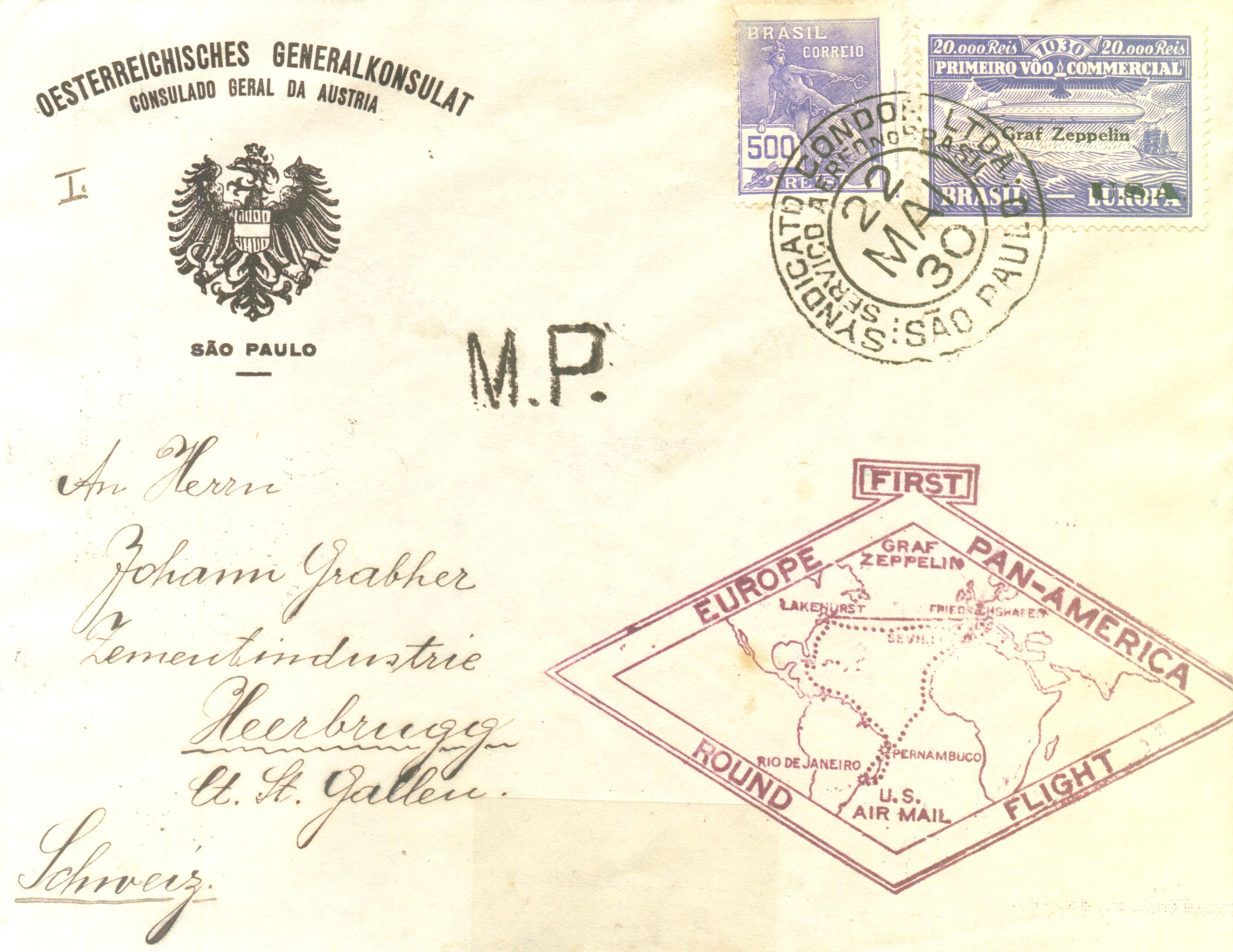 Figure 11: Austrian Consul
in Sao Paulo letter to a cement company in Switzerland near the
German-Austrian-Swiss triangle at the eastern end of Lake Constance.
Figure 11: Austrian Consul
in Sao Paulo letter to a cement company in Switzerland near the
German-Austrian-Swiss triangle at the eastern end of Lake Constance.
The next example, due to the fact that the envelope still contained the enclosed letter, is an example of a „official“ philatelic letter.
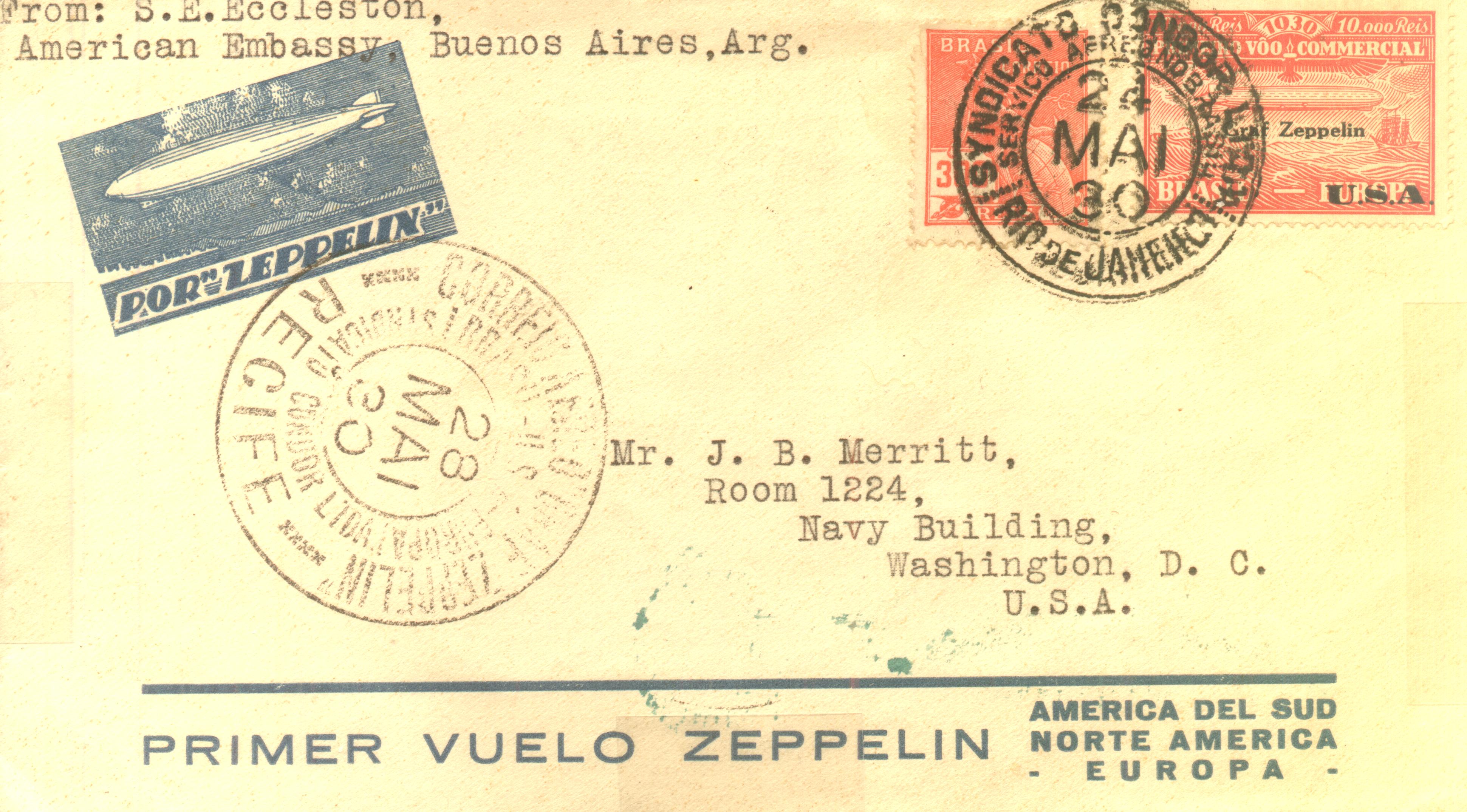 Figure
12: Cover send by the American Embassy in Buenos Aires with a
Brazilian franking /2/ to Washington D.C.
Figure
12: Cover send by the American Embassy in Buenos Aires with a
Brazilian franking /2/ to Washington D.C.
![]() Figure 13: The US Embassy
letter seal, in Spanish, on the back of the cover.
Figure 13: The US Embassy
letter seal, in Spanish, on the back of the cover.
Basically, Ms. Sarita E. Eccleston was sending this cover to Mr. Merritt in Washington D.C. And telling him about the fact that some covers out of Buenos Aires were being sent with Brazilian stamps. One could posit that Mr. Merritt was an official in the Navy Dept. (remember 1930 is pre-Pentagon era). In any case, with the use of the official letter seal on the back, an interesting cover (Fig.12,13).
The next cover could be considered a special private official cover. In his autobiography /3/, Dr. Eckener mentions that only due to the intercession of the wife of the US Postmaster General, Mr. Branch, did he manage to have a special stamp created for the American mail on this flight. And then there are the numerous USPO notices for this flight that were signed by the 2nd and 3rd Assistant Postmaster General. The second asst. was Mr. W. Irving Glover /4/ and taking a look at Fig. 14, one sees that Mrs. Branch wasn't the only philatelic wife among the Postmasters General.
![]() Figure 14: Glover letter,
via von Meister, using a penalty envelope.
Figure 14: Glover letter,
via von Meister, using a penalty envelope.
Here, a penalty envelope was used and sent to von Meister/1/ (i. e. #08851), and accordingly relayed, franked and sent back to D.C. Thus, a sort of private-official philatelic souvenir of this flight.
IV Class Three – The Real Thing?
Now comes the moment of truth (or consequences). This will be a tale of two covers. Displayed in Figures 15 (Hauck) and 16 (Vaughn), are two different covers, the second of which (Fig. 16) could be considered the real thing since the free frank is used in lieu of the required 300 Reis Brazilian postage for letters to the USA.
Both covers carry a diplomatic free frank marking (Figures 17 and 18) on the front, that interestingly are quite different from another. On the Hauck letter, the US Embassy part is a three liner compared to the Vaughn´s two liner. Also the “diplomatic mail free” frank shows a marked different in the “C” of diplomatic.
Whether the markings in Fig. 17 (Hauck) are kosher I, at present, can't confirm. Nor do I have a copy of the reverse side of the envelope to help clear up some doubts. Here I would appreciate any help from collectors who have seen or have copies of diplomatic covers sent from Rio de Janeiro. But what can be said is that for some reason the cover received an additional making (Fig. 19), in Portuguese (possibly the Brazilian postal authorities) that indicated that Brazilian postage was necessary and explains the 300 Reis stamp in addition to the Zeppelin franking.
![]() Figure 19: Brazilian postage
making
Figure 19: Brazilian postage
making
The Vaughn letter is addressed to Sherborn, Mass., a small town about 18 miles SW of Boston along the Charles river. Today's population is around 4500. An old city, founded in 1652. If this was an official letter, a vacation greeting, or a letter home by a staff member, the envelope got the diplomatic free frank that exempted it from the Brazilian part of the postage.
Figures 20 and 21 show the reverse as well as an enlargement of the US Embassy letter seal marking, that are highly relevant for the further discussion. Although the letter was being sent to the USA, where 10$000 would have been enough, the franking of the 20$000 seems to be an over franking. Furthermore, some might object since this letter to the US is not franked with a 20$000 overprinted “USA” version, but uses the „European“ version. The envelope itself is very heavy craft paper; it alone comes in with a weight of 10 grams.
Most probably the person sending the letter assumed that he had to pay more due to its higher weight. (US rates were for one ounce, the German rate was 20 grams). Maybe too, the 20$000 was all that was left easily available and the addresser just made a „jeito“, as Brazilians say in cases like this. Later research has indeed shown that “overweight” letters were allowed/sent from Brazil to the other destinations /6/.
To try to ascertain whether this letter could even exist with such a franking, an article by the postal historian, Richard B. Graham, proves to be very helpful /7/. In September 1921, in Buenos Aires, the Pan American Union (PAU) drafted a free mail convention, of which article 6 was relevant for free diplomatic correspondence for members of the PAU. Eventually the PAU turned into the current OAS (Organization of American States). Although the convention was agreed to in 1921, still in 1924, as Graham notes, the US Postal Laws and Regulations do not mention the fact that PAU members have diplomatic free franking privileges in the US. Finally on February 14, 1929, the US Congress passed a law finally allowing free diplomatic mail, even extending it to all PAU officials anywhere in the US. As Graham notes, very few covers prior to the 1930s have been seen.
Thus, this cover could very well really be kosher, since it is a little more than a year after the Congress finally got around to making the treaty terms reciprocal (only about 8 years after the fact!). This cover could be seen in light of the PAU treaty.
Obviously, it would be nice to know whether there are more letters like the above. As the Hauck cover demonstrates, there are other attempts that failed. Also the question of other letters from the other embassies included in the PAU. After all, at that time in Brazil's history, Rio de Janeiro was the “Distrito Federal”, i. e. Federal Capital. All the embassies were in Rio.
References:
/1/ Artur Knoth: Early Zeppelin Covers Bear von Meister Numbers; Linn's Stamp News 75(3846), 28 (July 15, 2002)
/2/ Zeppelin Post Katalog (22nd Ed.): bottom of page 105, Sieger-Verlag, Lorch Germany 2001
/3/ Dr. Hugo Eckener: Im Zeppelin Über Länder Und Meere; pp 297-9 (Verlagshaus Christian Wolff, Flensburg Germany 1949)
/4/ W. Irving Glover:“Graf Zeppelin“ Europe-Pan American Round Flight: Post Office Circular – Second Assistant postmaster General – Apr. 3, 1930 (U.S. Government Printing Office – 59102°)
/5/ Dieter Leder: private communication-jpeg copy of cover
/6/ Artur Knoth: Condor do Brasil Zeppelin Covers on the 1st Pan Am Zeppelin Flight of 1930 : the Rate Samba :; FFE #8, 127 (2005)
/7/ Richard B. Graham: Free Mails of the Pan American Union; Linn's Stamp News 61, 8 (November 14,1988)